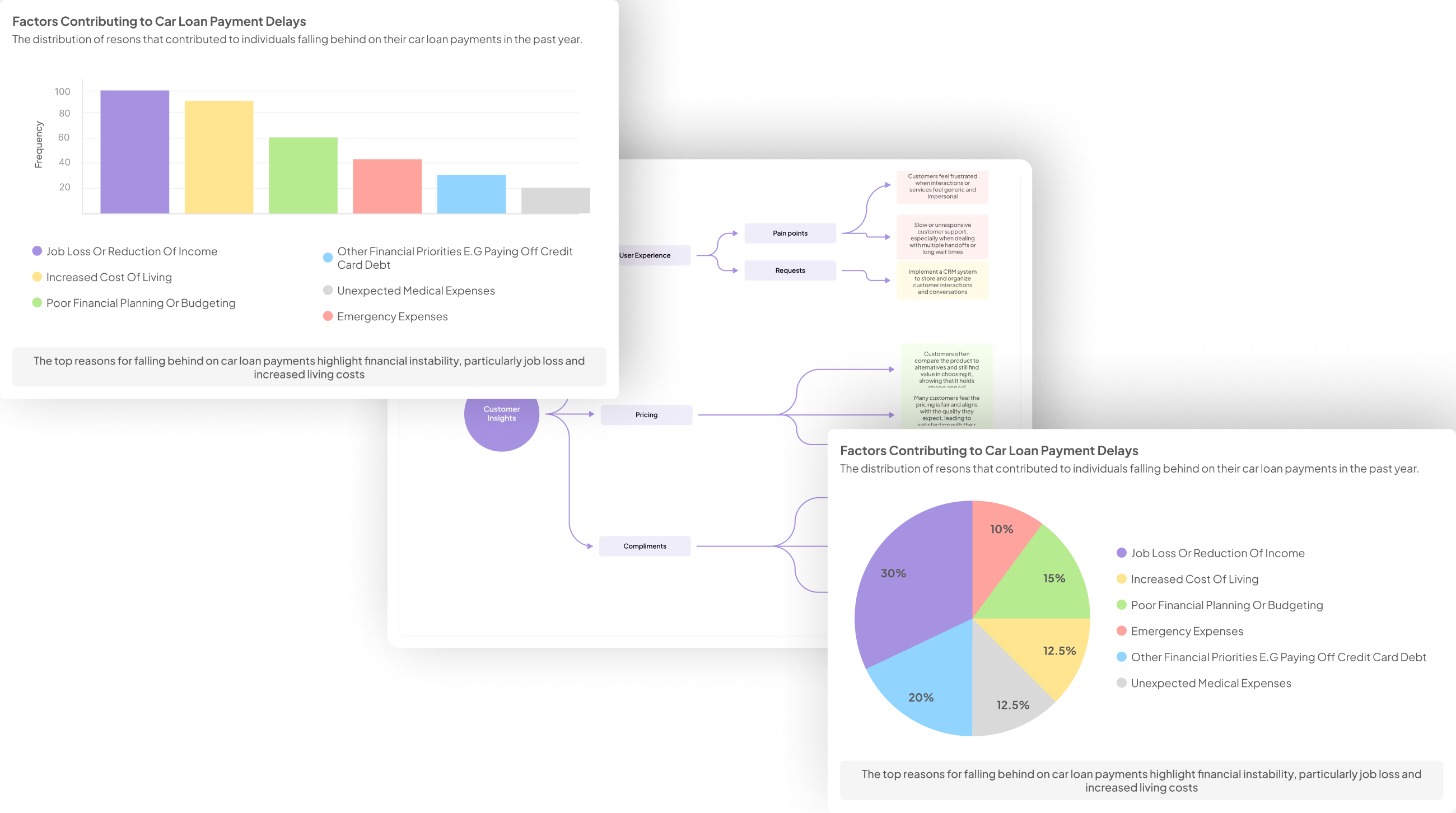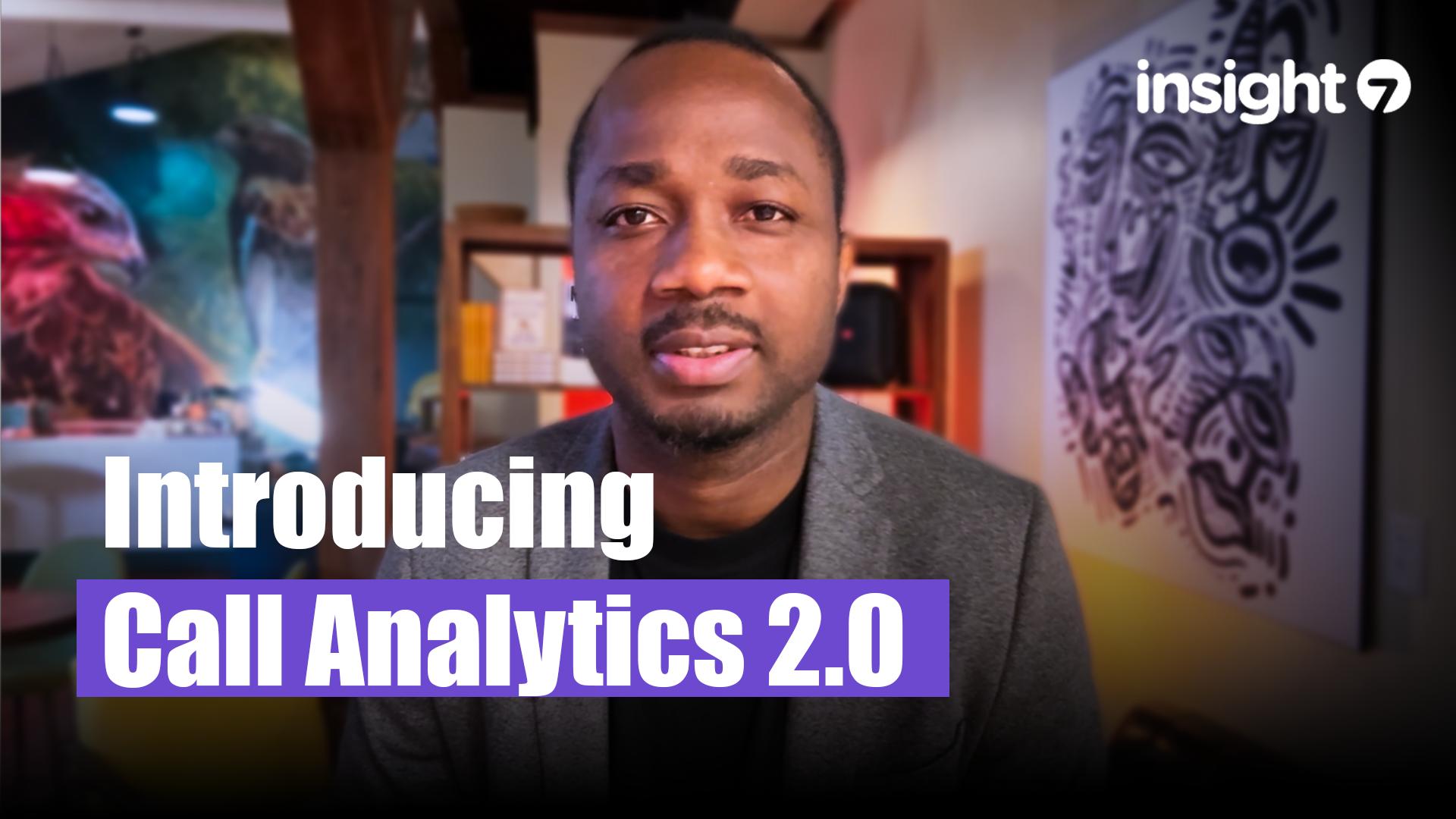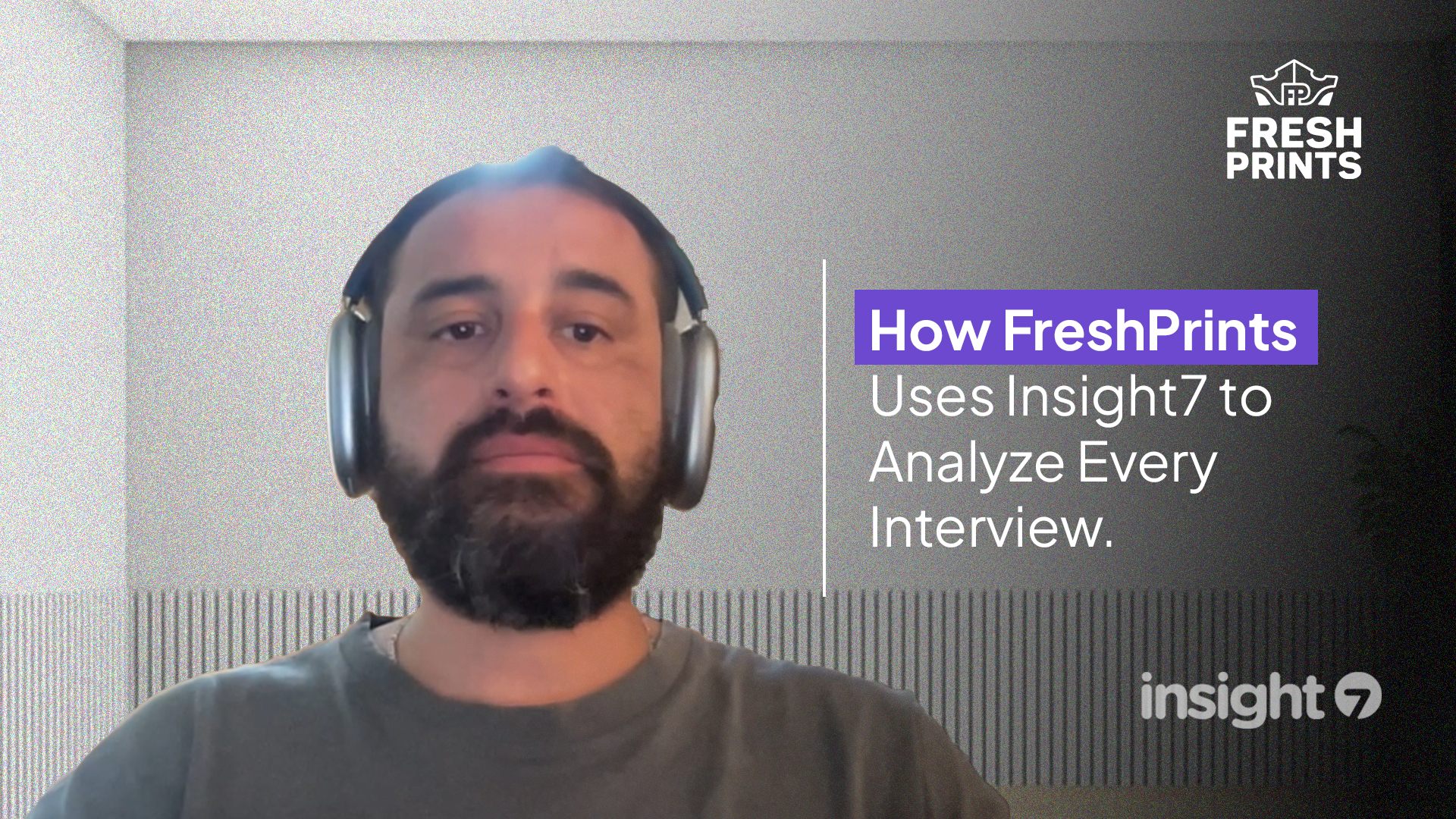Best AI tools for visualizing quotes from transcripts
-
Bella Williams
- 10 min read
In today's fast-paced digital world, organizations increasingly rely on transcripts to gather insights from meetings, interviews, and customer interactions. However, the challenge lies in extracting meaningful quotes from these extensive conversations. Quote visualization tools provide a solution, transforming dense text into visual formats that highlight essential quotes and insights. This transformation not only enhances comprehension but also enables quick access to impactful statements that can drive decisions and strategies.
Understanding how to effectively utilize quote visualization tools is vital for professionals seeking to harness data from transcripts. These tools offer innovative features that streamline the process of identifying key quotes, revealing patterns, and presenting the information in visually engaging formats. By employing AI-driven technologies, businesses can convert transcripts into actionable insights at unparalleled speed and efficiency, ultimately fostering a deeper understanding of their audiences and informing strategic initiatives.
Generate visualizations from your qualitative data. At Scale.

Quote visualization tools play a crucial role in enhancing comprehension and engagement with transcripts. These tools transform lengthy text into digestible visual formats, making quotes more impactful and memorable for audiences. By utilizing AI technologies, the visualization process not only retrieves essential quotes but also presents them in a visually appealing manner that captures attention.
The efficiency offered by quote visualization tools is invaluable, especially in professional settings where time is of the essence. With features like automated extraction of key phrases, users can quickly focus on pertinent information without wading through hours of dialogue. This capability supports clearer communication and helps convey the intended message effectively, whether for presentations, reports, or educational materials. Integrating these technologies into your workflow can significantly enhance how you share insights from transcripts and engage your audience.
Understanding the Role of AI in Quote Visualization Tools
AI plays a pivotal role in enhancing Quote Visualization Tools, transforming how we analyze and understand dialogue from transcripts. By integrating machine learning algorithms, these tools can extract meaningful quotes quickly and efficiently. The automation provided by AI not only saves time but also reduces the chances of human error in data extraction. As a result, users can rely on high-quality visualizations that summarize key insights from conversations.
Moreover, advancements in natural language processing enable these tools to identify sentiment and trends within quotes. This capability allows businesses to quickly pinpoint customer sentiments, which can inform marketing strategies or product improvements. With AI-driven quote visualization, organizations can seamlessly compile historical data and create engaging visual summaries. Ultimately, the application of AI fosters a deeper understanding of communication patterns, making it an indispensable asset in the realm of Quote Visualization Tools.
Benefits of Using AI for Quote Visualization
Using AI for quote visualization offers significant advantages that enhance the overall experience. One major benefit is enhanced data accuracy. AI algorithms can sift through large volumes of transcripts and extract relevant quotes with precision, reducing the risk of human error. This ensures that the quotes chosen for visualization accurately reflect the sentiments and intentions expressed in the conversations.
Another key advantage is time-saving automation. Traditional methods of quote extraction can be time-consuming and labor-intensive. AI-powered quote visualization tools can automate this process, allowing teams to focus on analyzing the insights rather than the manual extraction of data. By implementing these tools, organizations can streamline their workflows and respond to market changes faster, making data-driven decisions that are based on solid foundations. Embracing AI in quote visualization transforms how businesses interpret and utilize valuable insights from transcripts.
- Enhanced Data Accuracy
Accurate data is crucial for effective decision-making and analysis in any project involving transcripts. Enhanced data accuracy ensured by Quote Visualization Tools allows users to effectively identify and extract meaningful quotes. The precision of these tools reduces errors and improves the reliability of insights gained from data analysis. Consequently, users can make more informed decisions based on trustworthy visual representations of quotes that accurately reflect the original content.
To achieve enhanced data accuracy, there are several key features that Quote Visualization Tools typically offer. Firstly, they provide automated transcription services that minimize human error during data input. Secondly, sophisticated text analysis algorithms allow for context understanding, capturing nuances that may be overlooked in manual checks. Lastly, integration capabilities with various data sources ensure that all relevant information is consolidated, making it easier to contextualize quotes within broader discussions. This trifecta of features leads to enhanced accuracy, ultimately supporting better strategic outcomes.
- Time-Saving Automation
In the realm of Quote Visualization Tools, time-saving automation plays a crucial role. By automating repetitive tasks, these tools enable users to focus on analysis and decision-making. Rather than manually sifting through transcripts, professionals can efficiently access visual quotes, making the review process significantly quicker. This technology adapts to user needs, providing insights in real time and facilitating easier collaboration among team members.
Moreover, time-saving automation streamlines workflows and simplifies data management. Users can input multiple audio or video files and receive organized, visual outputs without extensive manual intervention. Features such as automatic transcription and keyword extraction enhance overall productivity. The time saved allows teams to emphasize strategic initiatives rather than tedious logistical tasks, leading to more meaningful insights and decisions in their projects. Embracing these advancements transforms how organizations approach information, making them more agile and informed in their actions.
How AI Transforms Transcripts into Visual Quotes
Artificial intelligence plays a critical role in transforming transcripts into visual quotes. By utilizing sophisticated algorithms and natural language processing, AI technologies automatically sift through large volumes of dialogue. This process quickly extracts meaningful quotes, allowing you to visualize key messages that resonate within a collection of conversations.
Initially, the AI identifies relevant phrases and sentiments embedded in transcripts. Next, it organizes this information into visually appealing formats, enhancing comprehension and engagement. This transformation is particularly useful for marketing teams seeking insightful customer feedback or compelling testimonials. By streamlining quote visualization, you save valuable time while ensuring your data is presented with clarity and impact, ultimately enabling more effective communication and decision-making processes.
- Key AI Technologies Involved
AI plays a pivotal role in Quote Visualization Tools, transforming raw data from transcripts into insightful graphical representations. Some key technologies involved include Natural Language Processing (NLP), Machine Learning (ML), and Automated Speech Recognition (ASR). NLP enables these tools to comprehend and interpret the context of spoken language, allowing for accurate extraction of quotes. This technology ensures that the meaning behind each quote is preserved even when inputted into various visual formats.
Machine Learning contributes by continuously improving the accuracy of quote identification and attribution, learning from past interactions to optimize future performance. Additionally, ASR technology enhances the speed and efficiency of transcribing spoken dialogue into text. Together, these technologies create a seamless process for analyzing transcripts and generating visual quotes that capture essential insights. Understanding these technologies can help users select the most effective Quote Visualization Tools for their specific needs, thereby enhancing their data interpretation capabilities.
- The Process of Analyzing and Visualizing Quotes
Analyzing and visualizing quotes begins with extracting meaningful excerpts from transcripts. To do this effectively, it’s essential to employ advanced Quote Visualization Tools that can automatically identify and collect relevant quotes. First, these tools allow users to input transcript data from calls, meetings, or interviews. Once integrated, the tools analyze the text, organizing it into categories based on sentiment or topic.
Next, the visualization process transforms these quotes into attractive graphics or data tables. By showcasing patterns and trends, users can quickly identify key takeaways. This step can involve highlighting customer testimonials or positive feedback that marketing teams can leverage. Ultimately, this structured approach not only saves time but does so with enhanced accuracy, ensuring that valuable insights are readily available for decision-making. With the right tools in place, the journey from raw transcript to meaningful visual insights can be seamless and efficient.
Evaluate Performance on Customer Calls for Quality Assurance.
Top Quote Visualization Tools Using AI
In the realm of digital communication, effective visualization of quotes from transcripts plays a critical role. Understanding the top quote visualization tools using AI can greatly enhance how organizations analyze and present valuable insights. These tools allow users to extract, analyze, and visualize quotes seamlessly, bridging the gap between raw data and actionable information. They empower teams to quickly identify trends and sentiments, making decision-making more informed and efficient.
Several notable quote visualization tools harness the capabilities of artificial intelligence. For instance, Tool 1 stands out for its user-friendly interface that simplifies the quote extraction process. Tool 2 leverages advanced algorithms to compress extensive data into insightful charts, making it easier to visualize customer feedback. Additionally, Tool 3 offers real-time analysis, enabling users to respond promptly to emerging trends. Other tools provide unique features like customizable templates or integration capabilities with existing systems. As organizations seek to derive deeper insights from their transcripts, these AI-driven tools serve as indispensable assets.
insight7: Leading the Way in Visualizing Quotes
In the realm of quote visualization tools, one platform stands out by transforming how businesses interact with customer conversations. By employing robust quote visualization tools, organizations can efficiently sift through vast amounts of transcript data, meaningfully illustrating insights gleaned from customer interactions. This not only aids in comprehending customer needs better but also enhances overall decision-making processes for businesses of all sizes.
Moreover, the unique capabilities of these tools bridge traditional data analysis challenges. They enable swift collaboration among teams by consolidating insights in an easily accessible manner. Instead of sifting through disparate files, users can visualize quotes in real-time, translating raw data into actionable strategies. As companies embrace this forward-thinking approach, they position themselves significantly ahead of their competitors, ensuring that valuable customer feedback translates seamlessly into tailored business actions.
- Key Features
Quote Visualization Tools provide an engaging way to present insights gathered from transcripts. One of the key features of these tools is their user-friendly interface, which makes it easy for anyone to access and analyze data without prior training. This democratization of insights allows team members across various departments to quickly create reports and identify trends in customer feedback and experiences.
Another important aspect is the ability to pull out specific insights from calls. These tools typically showcase pain points, desires, and behaviors through visual elements, enhancing comprehension. Insights are often displayed as cards that include quotes from customers, allowing users to see the evidence behind the insights. By making it simple to ask questions and retrieve summaries, these tools empower users to make data-driven decisions efficiently. Ultimately, the blend of accessibility and analytical power positions Quote Visualization Tools as essential for any organization aiming to enhance its understanding of customer feedback.
- Applications and Use Cases
Quote visualization tools serve a range of applications and use cases that enhance how we interpret transcripts. One primary application is in quality assurance. Organizations can evaluate customer interactions by analyzing transcripts, extracting relevant quotes, and assessing compliance with preset criteria. This helps ensure that employees meet performance standards and communicate effectively with clients.
Another significant use case is in market research. Analysts can visualize quotes from interviews or focus groups, identifying key themes and insights that drive strategic decision-making. This approach transforms raw data into actionable insights, improving the overall understanding of consumer behavior. Additionally, educators and trainers use these tools to create engaging materials that highlight important quotes, enriching learning experiences and providing clear references for discussion. By facilitating these applications, quote visualization tools not only simplify data analysis but also amplify the impact of the information derived from transcripts.
Other Notable Quote Visualization Tools
When exploring other notable quote visualization tools, it's essential to recognize their diverse features and unique capabilities that enhance the analysis of transcripts. These tools can offer straightforward methods for extracting meaningful quotes and presenting them visually. For instance, some allow users to compile quotes from various sources, effectively grouping related insights into accessible visual formats.
Tool A brings together multiple quoting methods, aiding users in spotting trends within dialogues. It features customizable dashboards that let you visualize sentiments and themes in real time.
Tool B is designed for comprehensive data analysis, focusing on user experience. It can integrate seamlessly with various platforms, enabling effortless extraction of quotes from recordings and written transcripts.
Tool C emphasizes collaborative features. This enables teams to work together on quote analysis, improving communication and decision-making.
Tool D showcases advanced tagging capabilities, allowing users to categorize quotes meaningfully, which simplifies retrieval later.
Tool E excels in visual storytelling. It transforms quotes into engaging infographics that can be shared across digital platforms, allowing for broader outreach.
These quote visualization tools serve various industries, elevating the way teams access and interpret information from transcripts for more informed decisions.
- Tool 1: Overview and Features
The first AI-driven tool for quote visualization offers an intuitive platform designed to make insights accessible to all users, regardless of expertise. Its user-friendly interface ensures that anyone can easily navigate through functions such as transcribing calls and generating comprehensive reports. The aim is to democratize access to important information, allowing users to understand customer experiences and identify friction points seamlessly.
Key features of this tool include a centralized library for storing transcripts, which users can analyze at both the individual call level and across multiple projects. Within the library, users can visualize conversations, extracting insights like pain points and customer desires effortlessly. The platform creates "insight cards" that combine evidence from conversations with actionable data so that users can summarize key themes and address issues effectively. This tool not only enhances workflows but also empowers teams to act on customer feedback, making it a vital asset for businesses looking to improve their services.
- Tool 2: Overview and Features
This tool excels in making quote visualization straightforward and intuitive for users at any level of expertise. Its user-friendly interface allows anyone in a company to access and harness insights without requiring specialized training. From the moment users log in, they can effortlessly manage projects, transcribe calls, and automatically generate reports for meetings.
Key features include a centralized library that consolidates conversation transcripts for easy analysis. Users can visualize discussions and extract actionable insights, such as customer pain points and desires. Each insight is accompanied by direct quotes as evidential support, effectively bridging raw data with real-world applications. This tool not only organizes and simplifies quote visualization but also empowers teams to ask questions and gain clarity from their data whenever required.
- Tool 3: Overview and Features
The third tool in our exploration of quote visualization tools offers user-friendly features designed to simplify the visualization of quotes from transcripts. One notable aspect is its straightforward interface, which allows users of all skill levels to engage with the platform effectively. The tool provides a centralized library for managing various transcripts, making it easy to navigate between different calls and extract meaningful insights. Users can quickly analyze individual calls, identifying key themes, pain points, and customer desires through powerful visual representations.
Additionally, this tool enhances the overall experience by offering actionable insights in a card format, revealing compelling customer quotes that substantiate findings. Users can track inquiries about conversations seamlessly, as the platform remembers any questions asked and generates summaries alongside pertinent keywords. This consolidated approach empowers users to manage multiple projects efficiently, enabling the analysis of extensive datasets in one go, ultimately driving informed decision-making through insightful visualizations.
- Tool 4: Overview and Features
Tool 4 stands out as a robust solution for visualizing quotes extracted from transcripts. Its user-friendly interface simplifies the process, making it accessible to individuals across various expertise levels. Users can effortlessly turn a collection of calls or transcripts into comprehensive reports, facilitating improved insights into customer interactions and experiences. The tool’s design promotes a democratized approach to analyzing data, ensuring that everyone can benefit from these insights.
Key features include a centralized library for all files, allowing easy access to transcripts and audio recordings. Additionally, it automatically identifies pain points, behaviors, and customer sentiments, ensuring that users can visualize key insights effectively. By utilizing evidence from conversations in the form of insightful cards, users can quickly summarize findings or delve into specific themes. This capability not only enhances understanding but also accelerates the decision-making process. Ultimately, Tool 4 elevates the experience of using Quote Visualization Tools, enabling better analysis and actionable insights.
- Tool 5: Overview and Features
Tool 5 offers an innovative approach to accessing and visualizing quotes from transcripts. This tool simplifies complex data, making it accessible for all users within an organization, regardless of their expertise. Users can begin their journey right from the homepage, enabling them to efficiently transcribe files or generate insights for reports. The platform’s design prioritizes ease of use, democratizing access to valuable customer insights across various workflows.
Key features include a central library for managing files and a robust analysis tool that extracts insights from conversations. With capabilities to identify pain points, desires, and behaviors, users can visualize conversations effectively. The system generates insightful quote cards as evidence, allowing for comprehensive analyses of customer experiences. Notably, users can also group multiple calls for broader insights, making it a versatile option among quote visualization tools. This interconnectedness ensures that organizations can derive actionable insights while saving time and resources.
Conclusion: Choosing the Right Quote Visualization Tool for Your Needs
When selecting a suitable quote visualization tool, several factors come into play, including features, ease of use, and integration options. Every tool offers unique capabilities that can enhance your understanding of transcript data. Take the time to assess your specific requirements and the types of insights you seek from visualizing quotes.
Ultimately, the right tool will not only facilitate data analysis but also present quotes in a meaningful way. By carefully evaluating available options, you can find a solution that streamlines your workflow and maximizes the value of your transcript data, making the analysis process both efficient and insightful.







